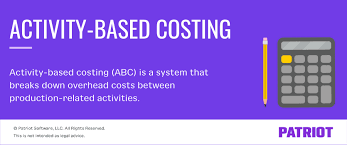ABC accounting is a system of accounting that offers the service of assigning overhead and indirect costs to the appropriate goods or services. In this post, you will find examples of the best ABC accounting you need for your business, and in order to understand ABC accounting further as well, go into detail with information on their services, especially tax services.
ABC ACCOUNTING
A costing method known as activity-based costing (ABC) assigns overhead and indirect costs to associated products and services. Unlike traditional costing methods, this accounting method of costing acknowledges the relationship between costs, overhead activities, and produced items, attributing indirect costs to products with less arbitrariness. However, some indirect expenditures, such as the salaries of management and office workers, are difficult to attribute to a product.
You can mostly use ABC accounting in the manufacturing industry since it improves the accuracy of cost data, resulting in virtually accurate costs and a better classification of the costs incurred by the company during its production process. Like I said above, you will mostly see the use of the ABC accounting system by manufacturing companies with large overhead costs. This is due to the fact that this accounting provides a clearer picture of where the business spends its funds. Another significant benefit of ABC accounting is that it provides detailed production cost breakdowns. This is critical because you will be able to discover which products are profitable.
Importance of ABC Accounting System and Method
Some of the importance of using an ABC accounting method is that it allows you to do the following:
- Take into account both the direct and indirect costs of producing each item.
- Recognize that different products necessitate various indirect costs.
- Set pricing more precisely.
- Check to see where you may save money on overhead costs
ABC Accounting Method
ABC is a new phrase that accountants coin in order to easily describe the process of cost estimation. The focus on activities is a key characteristic of ABC. It bases goods or service prices on activity. ABC is a costing system that allocates expenses to activities rather than items or services. This allows for a more precise allocation of resources and administrative costs to the products and services that consume them. ABC is a cause-and-effect mechanism for assigning the cost of items, services, consumers, or any cost object.
The ABC system is based on the idea that “activities consume products.” Traditional costing methods assign costs that have their basis in direct labor, material costs, revenue, or other direct approaches. As a result, traditional systems tend to over-cost high-volume items, services, and customers while under-costing low-volume products, services, and customers.
How the ABC Accounting Method Works
The reason for using ABC accounting most commonly in the manufacturing industry is that it improves the accuracy of cost data, resulting in virtually accurate costs and a better classification of the costs incurred by the company during its production process. The ABC technique assigns an organization’s resource costs to the products and services it provides to its customers through activities. Businesses usually use this to figure out how much a product or a customer costs and profits are directly related to the manufacturing or performing operations.
Objectives of ABC Accounting Method
I want to mainly use these 7 objectives below to throw more light on the ABC method, just so you understand how it works. They include;
- Firstly, because you don’t manufacture all products identically, you will require more accuracy in calculating the cost of products and services compared to the traditional costing system.
- In order to comprehend product customer costs, in order to comprehend product and customer costs.
- To comprehend profitability in terms of manufacturing or performing processes,
- In order to be able to conduct an organized examination of complicated processes,
- To offer management a variety of information to aid in decision-making
- Due to the variety of products, non-value-adding operations should not be visible.
- Develop value-added activities in light of the rapidly increasing diversity of consumer demands
ABC Accounting Services
There are a few companies that offer payroll, bookkeeping, and accounting services, and ABC Accounting Services is one of them. I will list a few of them that have good online reviews currently. These companies offer a range of ABC accounting services for clients, depending on your company’s needs. The companies include
- Jenny S. Park, CPA & Co. in California
- M. Losee & Associates in Kingston, Canada
- ABECK accounting, tax & computer services, Inc. in Norland
- R Rose & Co. Limited in Sheffield, UK
- Kirley Qureshi & Co. in Sheffield, UK
- Suttner accounting in Chilton, WI
- Bey & Associates in Washington, DC
- Accounting & business center in Birmingham, UK
Features of the ABC Accounting Method and Services
There are significant features you should look for in any ABC accounting service before consulting their services. These features will help you make the right decision on which of the ABC accounting services to use, and the features include;
- You pool the costs by basing them on the activities that they engage in while the production is ongoing rather than departments.
- Rather than utilizing an average overhead distribution rate as in the old technique, it charges overhead costs to products based on the activities involved in the product.
- Because of the easy traceability of costs according to activity cost drivers, it leads to more accurate cost information.
- It aids in the elimination of non-value-added activities, lowering the product’s per-unit cost. As a result, it aids in cost management.
- It allows for more precise costing of a product or job.
- It increases the number of cost pools that you use to collect overhead costs. You determine the number of pools by the activities that drive up costs. As a result, rather than accumulating overhead expenses in a single company-wide or departmental pool, you accumulate the costs by activity.
- Instead of a blanket rate based on direct labor expenses, direct hours, or machine hours, it charges overhead costs to different jobs or products in accordance with the cost-driving activities.
- It enhances overhead cost traceability, resulting in more accurate unit cost data for management.
Meanwhile, you should note that determining the cost of activities and their causes contributes to the determination of a more accurate cost of a product or service, as well as the elimination of non-value-added operations. The product’s cost would decrease if you typically eliminate non-value-adding procedures, and also, the product’s cost would decrease. After all, activity-based costing is all about this.
ABC Accounting & Tax Services
ABC Accounting and Tax Services focuses on helping small business owners and non-profit organizations with their accounting needs. The companies I listed above typically offer ABC accounting as well as tax services. The same five processes that you utilize in manufacturing can also be used by service firms. To comprehend the application of ABC in a service business.
Let’s have a look at how you can apply these procedures to determine the cost of bank loans. However, these companies use a step-by-step method to arrive at their results, and it is these steps that they use that I want to discuss in this part of this post. They include;
Step 1: Determine Which Activities Are Expensive.
Meeting with consumers, analyzing customer applications, and running credit reports are all part of the loan processing process.
Step 2: Assign Overhead Costs to the Tasks That You Identify in Step 1.
You can use the wages of workers reviewing applications, depreciation of computer equipment to review online applications, and supplies that you will require for the review process to cover all the costs associated with the activity of reviewing client applications.
Step 3: For Each Action, Determine the Cost Driver
In the third step, you need to determine the cost driver in order to move on to the next step and achieve an accurate result.
Step 4: For Each Task, Calculate a Specified Overhead Rate
You can accomplish this step by dividing each activity’s project overhead expenses by the expected cost of the activity.
Step 5: Assign Overhead Costs to Specific Items
The basis of this step is the utilization of each activity within the cost driver. This is because you allocate or apply overhead costs to goods (in this case, auto loans and home equity loans).
How to Record Overhead Costs When Using ABC Accounting and Tax Services
We demonstrated how to track actual overhead expenses and how to track overhead applied using a distinct manufacturing overhead account in a job costing system. With one difference, the cost flows for an activity-based costing system are the same. Rather than employing a single plant-wide overhead rate to assign (or apply) overhead to products, an ABC system uses multiple overhead rates. Whether the allocation involves one rate or numerous rates, the entry to record it is the same.
Simply deduct the amount of overhead applied from work-in-process inventory and credit manufacturing overhead. Some businesses keep separate accounts for work-in-process inventory and production overhead. For the sake of simplicity, we don’t use separate accounts. Remember that at the end of the period, you close the manufacturing overhead account to the cost of the goods sold. If actual overhead costs are higher than applied overhead, the gap between the two is filled by debiting the cost of products sold and crediting manufacturing overhead. If actual overhead costs are lower than applied overhead, the gap is bridged by debiting manufacturing overhead and crediting the cost of products sold.
What are the 4 steps of activity-based costing?
The ABC method consists of four steps: identifying the activities, assessing their size and base for allocation, calculating the predefined rate, and assigning overhead expenses.
What are the 4 levels of activity used in ABC?
Four separate levels of activity cost drivers are used by 4ABC to divide costs between resources and products. These cost factors include the resource-to-department, department-to-function, function-to-activity, and activity-to-product cost drivers.
What are the 3 pillars of costing?
By concentrating on the three pillars of effective cost management, you may download this guide to discover how to maximize your spending and make the best investments in digitization and growth: defining success in cost management precisely. implementing a standardized cost-management methodology. utilizing inter-functional cooperation.
What are the ABC methods?
What does ABC stand for? Antecedent, behavior, and consequence are abbreviated as ABC. Teachers can use it as an observational tool to examine what occurred prior to, during, and following a behavior. 1. One can consider all behavior to be communication.
Conclusion
After reading this post, you will understand that the ABC accounting method offers the best solution for your overhead and indirect cost problems. Furthermore, I hope you were able to find good firms online that offer the best services of the ABC accounting method for any purpose you wish to use it for, as well as understand that you need to apply the right example of the ABC accounting system that is suitable for your business and for tax services.
FAQs
What does ABC stand for in accounting?
Activity-based costing (ABC) is a method of assigning overhead and indirect costs—such as salaries and utilities—to products and services. The ABC system of cost accounting is based on activities, which are considered any event, unit of work, or task with a specific goal.
What is ABC costing with examples?
Gillian Davenport is a business writer with professional experience in finance and accounting. Key takeaways: Activity-based costing (ABC) is a method to determine the total cost of manufacturing a product, including overhead. It is calculated by taking the cost pool total and dividing it by the cost driver
How is ABC overhead calculated?
To calculate the per-unit overhead costs under ABC, the costs assigned to each product are divided by the number of units produced.
How is ABC different from traditional costing?
ABC is that costing in which costs are first traced to activities and then to products. Traditional costing system accumulates costs into facility-wise or departmental cost pools. The costs in each cost pool are heterogeneous- they are costs of many major processes and generally are not caused by a single factor.
Related Articles
- LIST OF MOST PROFITABLE SMALL BUSINESSES: Top 35 (+ detailed guide)
- VIRTUAL ASSISTANT BUSINESS: 2023 Detailed Start-Up Guide (+ Free Tips)
- CAPITAL GAINS EXEMPTION FOR SENIORS: How It Works 2023
- Long Put: The Complete Beginners’ Guide (+Quick Tools)
- MANAGING COST: 5 best keys for cost management
- COST PLUS PRICING: Meaning, Example, Advantages & Disadvantages






